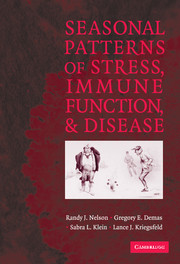Book contents
- Frontmatter
- Contents
- Acknowledgments
- Foreword
- Preface
- 1 Seasonality
- 2 Immune Function
- 3 Seasonal Fluctuations in Disease Prevalence
- 4 Seasonal Changes in Immune Function
- 5 Photoperiod, Melatonin, and Immunity
- 6 Energetics and Immune Function
- 7 Hormonal Influence on Immune Function
- 8 Clinical Significance of Seasonal Patterns of Immune Function and Disease
- References
- Index
5 - Photoperiod, Melatonin, and Immunity
Published online by Cambridge University Press: 11 November 2009
- Frontmatter
- Contents
- Acknowledgments
- Foreword
- Preface
- 1 Seasonality
- 2 Immune Function
- 3 Seasonal Fluctuations in Disease Prevalence
- 4 Seasonal Changes in Immune Function
- 5 Photoperiod, Melatonin, and Immunity
- 6 Energetics and Immune Function
- 7 Hormonal Influence on Immune Function
- 8 Clinical Significance of Seasonal Patterns of Immune Function and Disease
- References
- Index
Summary
In winter I get up at night, And dress by yellow candle-light, In summer, quite the other way, I have to go to bed by day.
Robert Louis Stevenson, 1885 A Child's Garden of VersesIntroduction
In the previous two chapters, we documented seasonal patterns of immune function, disease, and death in a wide variety of species. Seasonal phenomena may be imposed on animals by their environments. Alternatively, seasonal phenomena may reflect an interaction between individuals intrinsic seasonal clocks and the environment. If the second alternative is true, then individuals must coordinate internal seasonal rhythms with the environment. Most formal studies of seasonality have focused on day length, i.e., photoperiod, as the environmental cue used by animals to coordinate intrinsic seasonal rhythms with extrinsic seasonal environmental changes. In this chapter, we will review the formal properties of photoperiodism, describe how the pineal gland and its primary hormone, melatonin, mediate the physiological effects of day length, and finally document how photoperiod and melatonin influence immune function.
Photoperiodism, first proposed by the botanists Garner and Allard in 1922 to describe the response of plants to the length of day and night, currently is defined as the ability to determine day length in both plants and animals. Photoperiodism has evolved in virtually all taxa of plants and animals that experience seasonal changes in their habitats. Among vertebrate animals, photoperiodism is linked to a number of seasonal adaptations, including reproductive, metabolic, morphological, and, most germane to the topic of this book, immunological adaptations to cope with seasonal changes in ambient conditions.
- Type
- Chapter
- Information
- Seasonal Patterns of Stress, Immune Function, and Disease , pp. 115 - 150Publisher: Cambridge University PressPrint publication year: 2002



